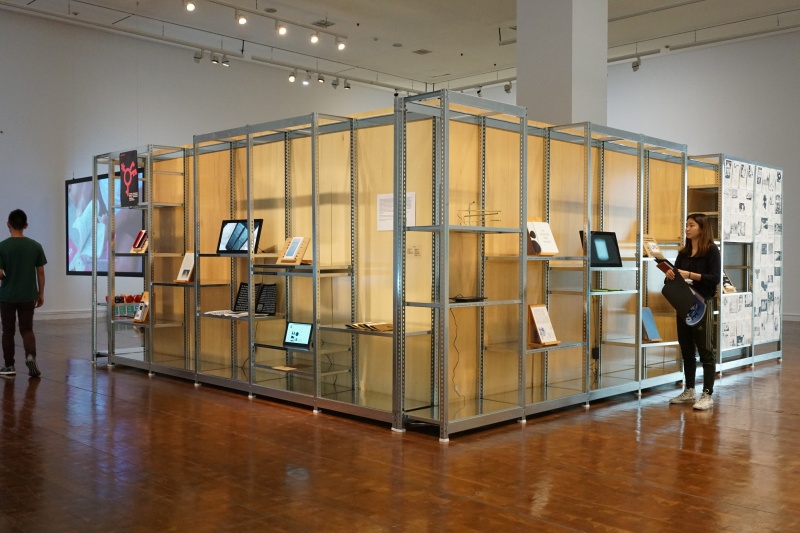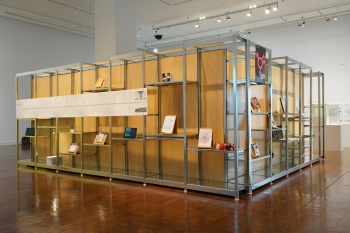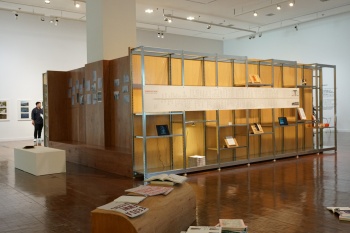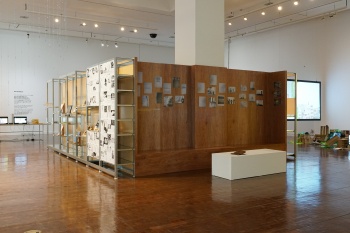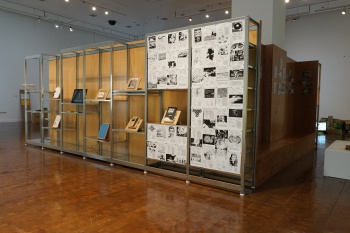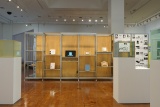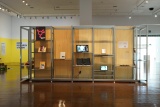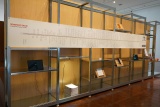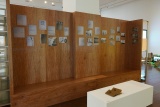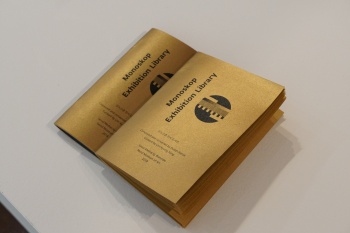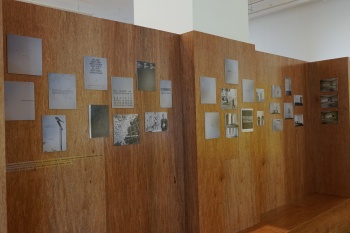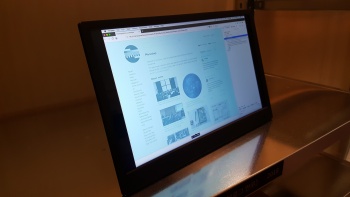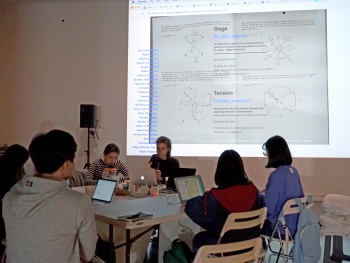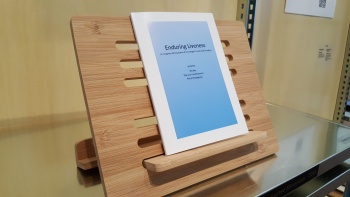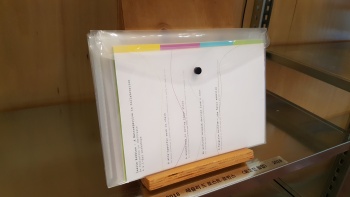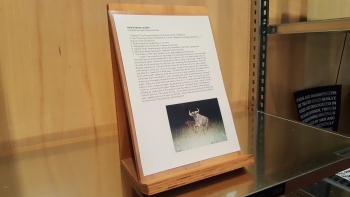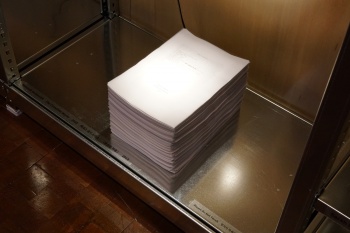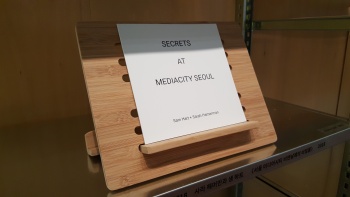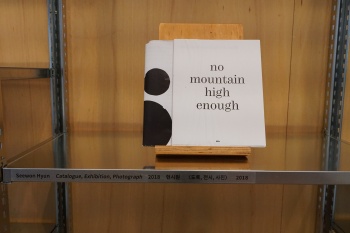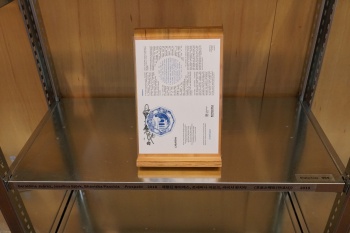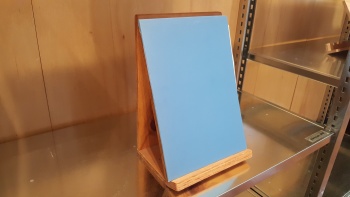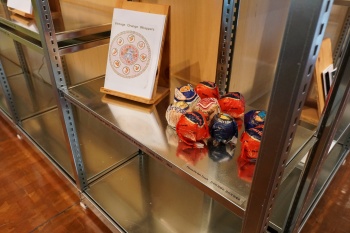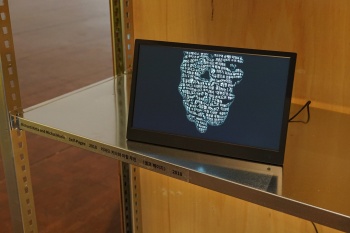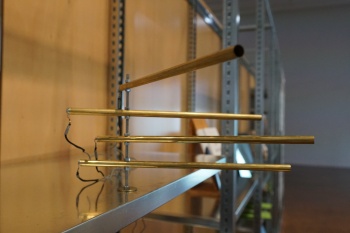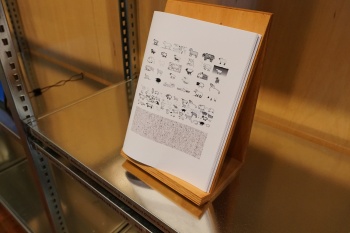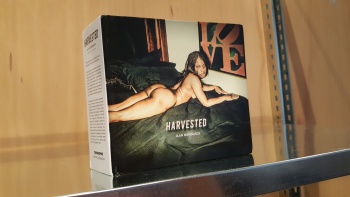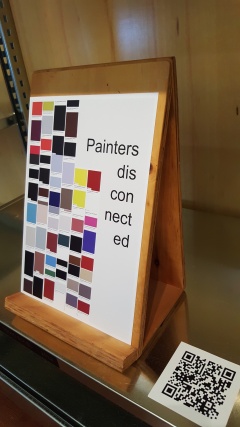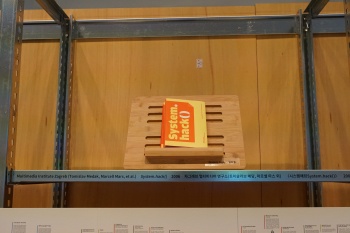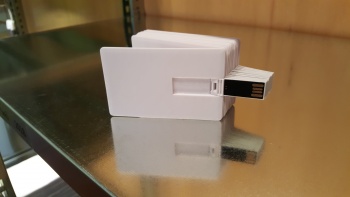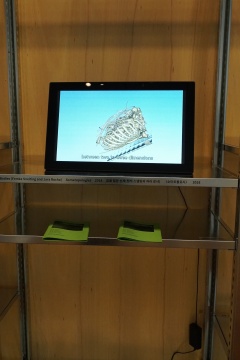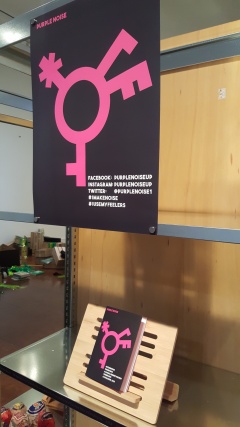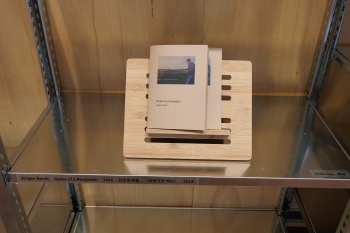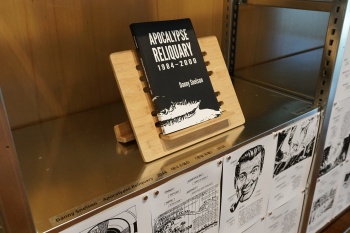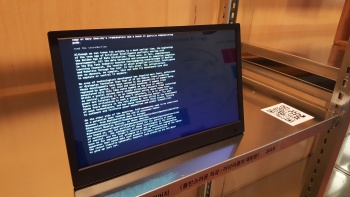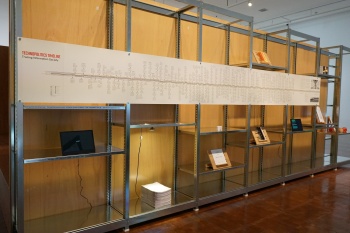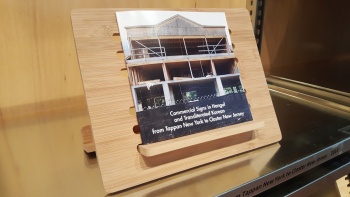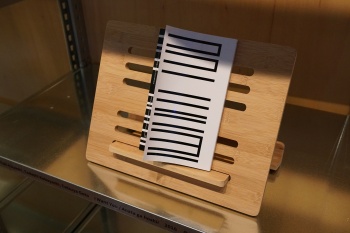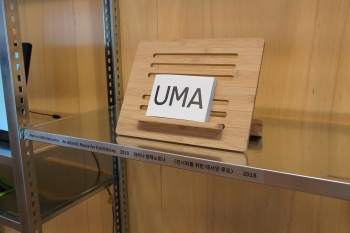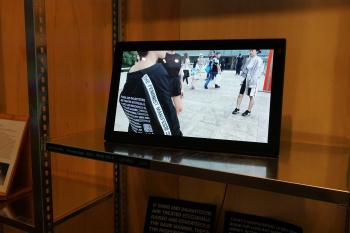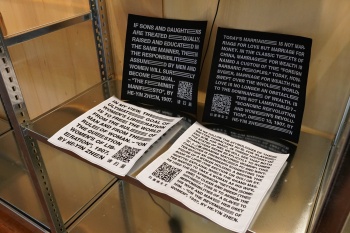Exhibition Library
The Exhibition Library reimagines the medium of art exhibition as well as that of art catalogue. Catalogues carry exhibitions through time and space, figuring as tropes for imagining arrangements and the course of works and settings they describe. However, they rarely give us a clue about what really happened, since they are often made before the show opens. Rather than documenting it, they often stand on their own, almost as if another work on display, truly as an artistic medium on its own. For this work, artists, designers, curators, poets and collectives created thirty catalogues of imaginary exhibitions. Exploring both the potential and impossible in art, the resulting exhibition library also serves as a “library of exhibitions.”
The premiere edition of Exhibition Library is presented as part of
- Seoul Mediacity Biennale 2018: Eu Zen
- Seoul Museum of Art
- Seoul, Korea
- 5 September – 18 November 2018
Contents
- 1 Invitation letter
- 2 Catalogue
- 3 Works
- 3.1 Monoskop in collaboration with the Archive of the Museum of American Art-Berlin
- 3.2 Joana Chicau
- 3.3 Joana Chicau (2)
- 3.4 Annet Dekker
- 3.5 Leslie Drost-Robbins
- 3.6 Espen Sommer Eide
- 3.7 Kenneth Goldsmith
- 3.8 Sarah Hamerman and Sam Hart
- 3.9 Seewon Hyun
- 3.10 Václav Janoščík and Eva Skopalová
- 3.11 Geraldine Juárez, Josefina Björk, Bhavisha Panchia
- 3.12 Lee Jungmin
- 3.13 Mara Karagianni and John Colenbrander
- 3.14 Richard Kitta and Michal Murin
- 3.15 Signe Lidén
- 3.16 Silvio Lorusso and Sebastian Schmieg
- 3.17 Ilan Manouach
- 3.18 Darija Medić
- 3.19 Multimedia Institute Zagreb
- 3.20 Michal Murin
- 3.21 Possible Bodies
- 3.22 Purple Noise
- 3.23 Jürgen Rendl
- 3.24 Danny Snelson
- 3.25 Supermuch
- 3.26 Technopolitics Working Group
- 3.27 Charles Turner
- 3.28 Takuma Uematsu, Yuki Hayashi, Tadashi Kobayashi, Tetsuya Goto
- 3.29 Marina Valle Noronha
- 3.30 Amy Suo Wu
- 4 Photo documentation
- 5 Credits
Invitation letter[edit]
Dear friends and collaborators,
Monoskop has been invited to create a work for the upcoming 10th edition of Seoul Mediacity Biennale. The biennial is shifting its focus to become more public-oriented event and we are happy to be part of this [1]. As a loose follow-up to the earlier initiative Ideographies of Knowledge, we decided to involve friends and collaborators of Monoskop and invite one hundred people and collectives to help us create an installation-exhibition. (cont.)
Catalogue[edit]
Download Exhibition Library catalogue PDF
Works[edit]
Monoskop in collaboration with the Archive of the Museum of American Art-Berlin[edit]
Remembering the "Seth Siegelaub: 'Exhibitions', 2069", 2018
"Seth Siegelaub: Exhibitions, 2069" was an exhibition related to the history of exhibitions. It was based on catalogues and photo-documents of the series of Siegelaub’s exhibitions from the late 1960s. Those were the exhibitions of Conceptual Art that expanded not only the notion of the artwork, but also the notion of the art exhibition itself.
These exhibition were remembered first through the paintings of the catalogues/documents presented at the “xero, kline & coma” gallery (London, 2011) and later at the Hessel Museum at Bard (2016).
These Siegelaub’s exhibitions are now being re-remembered through this exhibition based on the photo-reproductions of the paintings of the Siegelaub’s catalogues and installation views.
The Museum of American Art, which opened its doors in 2004 in Berlin, contains a collection of paintings and objects that ‘repeat’ significant works from 20th century American-cum-International Art History.
Joana Chicau[edit]
Choreographing a Catalogue, 2018
An art catalogue built on a ‘choreographic script’ which runs through a collection of URLs from the Monoskop online archive. Monoskop.org becomes a temporary stage for the script which gathers a series of images and text bringing-into-relation the different displayed results. Like a dance which goes from one archive material to another.
function dancing_catalogue() {
danceIndex = (danceIndex + 1)
% dance.length;
document.getElementById
("stage").src = dance[danceIndex];
}
setInterval("dancing_catalogue()",2000)
Joana Chicau is a graphic designer, creative coder and researcher with a background in classical and contemporary dance, currently based in The Netherlands.
Joana Chicau (2)[edit]
The Anatomies of Art Catalogue, 2018
This workshop is set to explore the notion of catalogue: articulations between form(s) and content(s), time(s) and space(s). The participants are invited to engage with hybrid physical and digital (open source) tools, and overlaying techniques. The workshop may be seen as a temporary lab to collectively share methodologies and discover modes of structuring new cataloguing possibilities and formats.
Method = somatic practices (movements, gestures, relations between bodies in time and space)
+ archiving practices (searching, collecting; structuring and presenting content);
Structure = introduction; embodiment exercises; prototyping; presentation and discussion.
Outcome = creating a catalogue which represents an imaginary exhibition;
The catalogue is here seen as the culmination of cultural bodies; political bodies; poetic bodies; imaginative bodies and the power to evoke other bodies and future anatomies to come. Opening up the horizon of what a catalogue is; or can be.
References:
- “To explore the nature of ‘thinking in action’ or thinking-feeling-knowing’ operative within artistic practice, especially produced within collaborative exchange..” — Emma Cocker, et al.
- “... an approach to research-creation as a practice of interdisciplinary event design, or to quote the original application, as the practice of creating innovative ‘platforms for organizing and orienting live, collaborative encounters.’” — Erin Manning et al.
- "The body is an arrangement in spacetime, a patterning, a process; the mind is a process of the body, an organ, doing what organs do: organize. Order, pattern, connect... an immensely flexible technology,or life strategy, which if used with skill and resourcefulness presents each of us with that most fascinating of all serials, The Story of My Life." — Ursula K. Le Guin (Dancing at the Edge of the World: Thoughts on Words, Women, Places)
The workshop takes place on 2 November 2018 from 2-7 PM in Agora, Seosomun Main Building, Seoul Museum of Art. Please subscribe on third floor at 3-13.
Annet Dekker[edit]
Enduring Liveness: An Imaginary Retrospective of Tino Sehgal’s Constructed Situations, 2018
The key functions of a museum are the collection, presentation, preservation and education of cultural and artworks for the enjoyment of, and to educate, the public. Performance art has been notoriously difficult for museums to handle, despite the ‘easy’ presentation the non-materiality of the art form challenges the conventional methods and practices of a museum. Artist Tino Sehgal had added to these problems, persisting in having no documentation of his performances, or better his ‘constructed situations’, in whatever form or way. While several books and some catalogues are written about his work, none of them show visual representations of the actual performances.
While I sympathize with Sehgal’s aims and ideas, I’m also intrigued by the numerous ways in which documentation developed and expanded in the last two decades with more and more photos and videos appearing online. In this catalogue three perspectives are presented that open up the potential of documentation as a method to generate new articulations and ways of understanding, thinking and performing. Countering the “no photos allowed” from the press statements of the museums, with the documentation used by online news outlets and those created by visitors, the experience of being present at the performance can no longer be considered as a fixed or even final perspective. Instead the constructed situations continue to act through viewing, capturing and circulation. Navigating the various documents that are created idiosyncratically according to access (having a camera and an Internet connection) or choice (having the willingness or courage to take an image and change the rules), the Imaginary Retrospective of Tino Sehgal adds to what theatre and performance scholar Sarah Bay-Cheng beautifully describes as “a multi-valent experience that is shaped and constructed by the individual experiences, choices, and negotiations of all parties within a connected network of information, sensations, and varying access points” (2012). At the same time, it might open up a desire for new performance to emerge.
Annet Dekker is an independent curator, Assistant Professor at University of Amsterdam and co-director of the Centre for the Study of the Networked Image at London South Bank University.
Leslie Drost-Robbins[edit]
A Retrospective in Collaboration, 2018
“When asked by the Seoul Museum of Art for this retrospective, I questioned the significance of shipping costly artworks and re-exhibiting well documented performances to the Museum's audience. I'd found on-line many more of these 'Western retrospectives'* from better known artists than myself, and I had doubts about the works reaching the viewers and challenging them as they had done for me. I was about to decline the offer when Dušan Barok, editor of Monoskop.org, contacted me. Dušan said he'd be participating in the Seoul Mediacity Biennale 2018 at the same time as my retrospective. While reading up on this year's 10th anniversary event, and how the "Collective" wanted to structure it, an idea was planted.
I proposed inviting Mediacity participants to (Re)create my retrospective through a series of four workshops that could be worked out in no particular order using a workbook that I'd write.
The day-long Workshops offered are:
- A site-specific work in chalk
- A soundtrack to moving image piece
- An activist artwork derived from a text
- A Tangible Archive – the Seoul addition
The workshop, A site-specific work in chalk requires a team effort resulting in one outcome. The others are suited to individuals or small groups whose participation produces a series of outcomes. The participants of each workshop are asked to work together closely, collaborating as needed on everything from the day's schedule to joint decision-making processes. Every workshop includes time to reflect at the end of the day.
The Workbooks:
The Workbooks are contained in
an envelope on four cards. One side of
the card describes the workshop. The other side will display examples of my previous work and bits of inspiration.
How each Workbook works:
Participants read each edition as
an invitation, interpreting and responding to it from their perspective formed by local social values and current concerns. Please make sure you document your efforts at http://lasloplanet.org/mediacityseoul and schedule the day to allow time to sit as
a group and discuss the day's adventures.”
Leslie Robbins, visual artist with a passion for public space and work ranging from large scale sculptures on two continents to her handheld tangible archive of Wooden Soldiers.
Espen Sommer Eide[edit]
Animal Dream Studies, 2018
At night, even in the most remote areas of the earth, animals dream about humans. These dreaming animals carry human ways of visualizing the world. They are hybrid beasts that perfectly fit our modern conception of the planet as an environment under constant watch. What does a human figure symbolize in animal dream interpretation? Do creatures dreaming about us dreaming about them open up a new relationship between humans and animals? Can a sleepwalking person ride a sleepwalking horse? Questions such as this are posed by the various works of this large-scale exhibition around the subject of animals and dreams.
Espen Sommer Eide is a composer and artist based in Bergen, Norway. Using music as a tool, his works investigates themes ranging from the linguistic to sensory biology, including the invention of new scientific and musical instruments for performative fieldwork.
Kenneth Goldsmith[edit]
The Complete Works, 2018
“For this catalog series, I wanted to create a catalog of my own works, which are in a sense indexical catalogues of preexisting texts. By reformatting a text that already exists and calling it literature, it becomes a part of a catalogue, a sort of Borgesian library. I wish that all texts—especially the most mundane ones—could be entered into the catalog of literature. If all texts were literature, then we’d no longer need literature, something I very much look forward to and am working towards. So by collecting and cataloguing everything book I’ve published, The Collected Works becomes strange to me – objectified and foreign, and in doing so becomes new to me again. Now I can open any page of my collected works and be surprised by what I read—and in this way, I become my ideal reader.”
Kenneth Goldsmith is a poet living in New York City. He teaches at the University of Pennsylvania and is the founder of UbuWeb, the web’s largest archive of avant-garde art.
Sarah Hamerman and Sam Hart[edit]
Secrets at Mediacity Seoul, 2018
Secrets at Mediacity Seoul traces a genealogy of artworks that examine the secret as an information structure, from the conceptual artworks of the 1960s to works that consider secrecy and encryption in today's social and technological context. While conceptual art's logic of dematerialization often undergirded an aesthetic of 'pure' information, it led artists from Douglas Huebler and Robert Barry to Mel Ramsden and Sophie Calle to investigate how secrets test the limits of what can be known and seen. But the role of secrets is political as well as epistemological. Works by artists such as Trevor Paglen, Jill Magid, Paolo Cirio and Hayal Pozanti consider how secrets organize the distribution of power, from algorithmic “black boxes” and state classification schemes, to new digital infrastructures built upon cryptographic primitives. Finally, Secrets at Mediacity Seoul looks beyond the catalogue's documentary role, imagining how it might conceal or encrypt the absent artworks. The Secrets at Mediacity Seoul forms part of the Secrets research and curatorial project (2017-2018), a collaboration between Sarah Hamerman and Sam Hart.
Sarah Hamerman is a librarian and arts researcher based between New Jersey and New York City. She currently works as Poetry Cataloging Specialist at Princeton University Library. Sarah is also a founding member of the Cybernetics Library.
Sam Hart is a New York-based scientist and publisher working across computational biology and distributed publishing. He is a founding member of Avant.org, the Cybernetics Library, and Guild.
Seewon Hyun[edit]
Catalogue, Exhibition, Photograph, 2018
“I do not see anything unless I open the book again. When the book is opened, there is a possibility of a handful that can enter this exhibition. I do not know who said that the exhibition is empirical. Why is the experience or case study important? Because the exhibition lives only once. I am thinking about an exhibition with only a voice, and an audio book may be enough. I sometimes output a large amount of photos by artists, friends or photos I take, with SNAPS application. I like to see the date of these images. Also, it is interesting to print some photos of exhibition with small size.”
Seewon Hyun is co-director of Audio Visual Pavilion and an independent curator. As a curator, Hyun curated exhibitions including Human Scale (co-curator, 2014) at Ilmin Museum of Art in Seoul, and Chunsoo Mart 2nd Floor (2011 and 2012) at National Theater Company of Korea and Festival Bom in Seoul.
Václav Janoščík and Eva Skopalová[edit]
Back to the Future: For New Histories of Materialist Art, 2018
With a dose of naiveté we may claim that the most significant shift within the artworld of past years (or at least its theoretical basis) has been the dissipation of (post)conceptual art and the rise of diverse strands of materialisms in the opposite vector.
However, material interests in art practice are far from new and it is necessary to point out instances of these tendencies in history, for example marble frescoes under Madonna delle Ombre in San Marco monastery and the rider in the clouds in Andrea Mantegna's painting of Saint Sebastian.
This can be paralleled with shifts in philosophy from the dominance of poststructuralism to flirtations with various speculative and realist approaches. While after Kant, philosophy focused on critique and (social) construction of reality, what we face now is the resurgence of realist and materialist thought.
The idea of transcending from the material to the immaterial was commonly used in religious paintings. For example, through pictorial rupture in the sky we can get access to metaphysical world, the sphere of God.
What becomes more than clear by now is that material tendencies have been active in the entire tradition of history of art and thinking. Our exhibition aims at tracing a concise yet full-fledged genealogy of material-oriented art.
We are grateful for financial support from the IFF (Institute of Fictions and Futures, Prague) without which we would not be able to gather the artworks and especially, we would not be able to extract Fra Angelico frescoes from San Marco monastery.
Václav Janoščík (1985) is a pedagogue, theorist and curator. He works as an assistant professor at the Academy of Fine Arts, Prague and the Department of Photography at FAMU, Prague. His focus is on philosophy, media theory and art theory.
Eva Skopalová (1991) graduated from the History of Arts at the Charles University, Prague and Theory and History of Contemporary and Modern Art at UMPRUM, Prague. Her current focus is on anachronism and its impact on the history of art.
Geraldine Juárez, Josefina Björk, Bhavisha Panchia[edit]
Prospekt, 2018
- Script, VR and 3D by Geraldine Juárez
- Performed by Josefina Björk
- Curated by Bhavisha Panchia
A VR-essay and performance, Prospekt is a gaze guiding its audience through an exhibition. Tracing practices of colonial knowledge production and bio-prospecting to the modelling of contemporary data-prospecting shaping the “digital economy” today, Prospekt probes into the systematic search for economically valuable resources that are future oriented.
Information corporations monopolise data, which in turn, monopolise memory, and consequently power. This is the relationship between culture, data and the economy. By institutionalising information gathering practices they dominate the ways in which imagings of the world are produced, classified and observed. The display of the-world-as-an-endless-digital-exhibition, expanding on the accounts of Derek Gregory and Timothy Mitchell, is the evolution of a thriving practice dating back to colonial bio-prospecting and the development of display techniques from the diorama of the early 1800s to today’s VR headsets. Exploring these continuities across practices that overlap, Prospekt brings into focus the logic and mechanisms behind corporate investment in digital institutionality.
Platforms, devices, architectures and techniques of display bring distant objects, artefacts and documents into proximity. They are used to map, organize and manage the world’s information, and assert Michel de Certeau’s proclamation that “In history, everything begins with the act of separating, gathering, and turning certain objects that were otherwise distributed into ‘documents’.” Existence is affirmed through perpetual capture: nature into culture into data. All as an endless-digital-exhibition.
Organising information is never innocent.
Geraldine Juárez is a Mexican-Swedish visual artist using time-based media, sculpture and performance to consider the materials, histories, technics, politics and economics shaping the dominant narratives and contexts in contemporary media culture.
Bhavisha Panchia is a curator and researcher of visual and audio culture currently based in Johannesburg, South Africa.
Josefina Björk is a Swedish artist and performer. Her practice revolves around participatory performances, both in her own projects as well as in her collaborations with other artists.
Lee Jungmin[edit]
Log Book, 2018
Portfolio reviews are exhibitions and performances which take place over a short period of time through photographs. Following brief meetings of 20 minutes each, she follows the works and artists and sinks like a diver into a world, culture, and history. This diving makes the virtual which dreams of realization.
Lee Jungmin studied photography and aesthetics and works as a curator. She co-curated Seoul Luna Photo and The Scrap.
Mara Karagianni and John Colenbrander[edit]
Vintage Orange Wrappers, 2018
For Lothar-Günther Buchheim, who in the 1950s, 1960s and even the 1970s carefully smoothed out every orange paper he came across and kept in albums, the pictures that were printed on the feather-light wrapping papers of citrus fruits were Pop Art in the best and most original sense.
In 2011 the Buchheim Museum of Fantasy planned to exhibit a selection of about 200 of the colorful "miniature posters", but within one week before the opening his brother, Klaus-Günther Buchheim, claimed that the material for the show was his and not from his brother. In the ensuing lawsuits the exhibition took place but the catalogue was ordered to be destroyed.
Only one copy survived.
Mara Karagianni and John Colenbrander met in Rotterdam, married each other and work together to make life easier. Presently they discover Greece by canoe.
Richard Kitta and Michal Murin[edit]
Self-Pages, 2018
This work represents a model of a hypothetical book in virtual environment. Its concept is based on the understanding of the book as a hierarchical functional object that has its packaging, volume, shape, shell, its content, references, memory, and linear structure. The fluidity of its imaginary pages disrupts the left-to-right reading convention, but it also assumes the act of writing that defined it, which is nonlinear in this case. Synthesis and reconstruction of the virtual book in the form of animation is one of the potential solutions or one of the many algorithms that defines it at a given moment.
The assumed introductory and imprint pages, pages containing graphs in an unknown language, pages containing picture material and references, and blank pages are made of fluid, undefined material. The transition between the pages gradually vanishes, the book is a digital continuum, the question arises whether it is capable of reading itself. A part of virtual matter (errata) is flowing outside defined framework, finds itself in the irrational space (space-of-space) and is forever lost. Somewhere inside, however, information is kept which does not penetrate the surface, it constitutes a sacrosant volume of data. Analysis-synthesis-analysis is an authorial narrative, it supports the apparent gradation of the work. The virtual data defined somewhere in the beginning of this combinatorial game is mixed, bent, drained, there only remains an unreadable core. Although the content of the book is open, it is forever locked not only from its readers but also from its authors.
Richard Kitta (1979) is a multimedia artist, pedagogue and cultural activist. His work involves interactive objects, digital environments and visual poetry. He is a co-founder of DIG Gallery in Košice, Slovakia, and editor-in-chief of the ENTER magazine.
Michal Murin (1963) is a conceptual artist focusing on intermedia and sound art. He also works as a publisher, editor and teacher.
Signe Lidén[edit]
Weather Reports Back, 2018
The commission Weather Reports Back from the South Korean artist duo Jiyeon Kim and Gangil Yi is a live streaming instrument installed at the facade of International Atmosphere Preservation Center ran by artist Amy Balkin. The stream started exactly one year after the earth's atmosphere was submitted to the UNESCO's World Heritage list and will run far into the future.
Signe Lidén is an artist based in Bergen and Amsterdam. Her work examine man-made landscapes and their resonance and spans from sound installations, sculpture, video and performance to more documentary forms such as sound essays and archives.
Silvio Lorusso and Sebastian Schmieg[edit]
Artworks That Use Online Outsourcing To Talk About Online Outsourcing, 2018
A collection of artworks that make use of online outsourcing platforms such as Amazon Mechanical Turk, Upwork, and Fiverr in order to artistically engage with online outsourcing.
Silvio Lorusso is a designer witouth qualities, an artst without a gallery and a writer without spell cheker.
Sebastian Schmieg's work engages with the algorithmic circulation of images, texts and bodies, tracing new hybrid structures that blur the boundaries between human and software, individual and crowd, or labor and leisure.
Ilan Manouach[edit]
Harvested, 2016
More than two thousand adult movies were bulk harvested from peer-to-peer websites directly to a server location. Following two separate scripts, the clips were automatically trimmed down to the first ten minutes and then broken into thousands of low-quality JPEG snapshots waiting to be filtered. The pool of images was later submitted to crowdsourcing services that enable the coordination of human intelligence to perform tasks that computers are currently unable to do. A selected group of microworkers was asked to filter thousands of these images according to an intentionally vague instruction: whether or not they contain contemporary art.
Harvested brings to the foreground five-hundred found artworks from households, studios, movie sets and other heterotopias of the adult film industry. While this anthology underlines the importance for a contextual, industry-specific art history, by the same token it posits the need to activate peripheral vision in regard to scopophiliac practices. While IKEA paintings are pervasively dominant, one can find works from modern masters such as a rip-off from Fernand Léger, an unknown Joan Miró, Castle and Sun from Paul Klee but also contemporary works such as Quote, 1964, a print from Robert Rauschenberg, a series of paintings from Mark Rothko, School of Fontainebleau from Cy Twombly and even some replicas from Frank Stella and Lucio Fontana. The book is a co-production between publishers in Portugal, Denmark, Switzerland, France, Belgium, Greece, Italy, Spain, Mexico and South Africa.
Ilan Manouach is a musician, a book publisher and a multidisciplinary artist with a specific interest in conceptual and post-digital comics.
Darija Medić[edit]
Painters Disconnected, 2018
Painters Disconnected is a series of mobile web screenshots showing Google Image search results for paintings of famous artists as they are shown before the website loads. What they reveal is a mosaic of images with a predefined layout and color scheme for each search/artist. The color-coded Mondriaan-like series of rectangles only becomes visible in cases of slow Internet connection, pausing the seamless high-speed transfer of data. This pattern also reveals algorithmic decision-making behind the ordering of images, becoming a catalogue in itself. Image search collections are archived per individual painter on an Instagram account.
Darija Medić is a post-new media practitioner and researcher, working in the fields of media art, critical writing, curating and production.
Multimedia Institute Zagreb[edit]
- Tomislav Medak, Marcell Mars, et al.
System.hack(), 2006
A moment of excellence in programming is called a hack. A perfect hack is surprising, mediagenic, innovative in employing technology, funny and non-violent. System.hack() is every hack that opens up a closed system or makes an open system dynamic.
System.hack() exhibition seeks to find connections between moments of excellence in different fields of human production. This exploration always has to provide answers to the following two questions: What system is being hacked?, and How this system is being hacked, or what is a specific hack in an individual work?
The exhibition environment is not a gallery, but the interior of a hotel room. The hotel room is supposed to function as the lowest common denominator of living environments users / viewers / visitors / readers inhabit. The hotel room also functions as a Table of Contents for the System.hack() book.
Tomislav Medak is a philosopher with interests in contemporary political philosophy, media theory and aesthetics. He co-founded the MaMa – Multimedia Institute, Zagreb in 1999.
Marcell Mars is a free software advocate, cultural explorer, and social instigator. He co-founded the MaMa – Multimedia Institute, Zagreb in 1999.
Michal Murin[edit]
USBook, 2018
The works artists forgot to make.
A catalogue of a hypothetical exhibition whose theme was a presentation of works of art which have not been created because the artists forgot to make them, in spite of they had been commissionedfor the exhibition.
Every so often, it happens that an artist is invited to a thematic exhibition to create new work responding to the curator‘s vision or initiator‘s call. In the rut of daily routine, sometimes andto someone even more so it occurs that the artist forgets to make a commissioned work for an exhibition. The uncreated works of artists obviously do not exist in their final form, even though they at least thought about them. The work USBook is a catalogue of non-created, non-existent and non-exhibited works which can still be made.
Michal Murin (1963) is a conceptual artist focusing on intermedia and sound art. He also works as a publisher, editor and teacher.
Possible Bodies[edit]
Somatopologies, 2018
Somatopologies contains 3D-renderings of diverse densities, wondering about the regimes of truth that converge in volumetric biomedical images. There is a coalition between tomography and topology at work to align math, flesh, computation, bone, anatomic science, tissue and language. But when life is made all too probable, Possible Bodies asks obliquely: what other "bodies" can be imagined?
Somatopologies moves through the political fictions of somatic matter. Rolling from outside to inside, from a mediated exteriority to a computed interiority and back, it reconsiders the potential of unsupervised somatic depths and (un-)invaded interiors. Unfolding along situated surfaces, this post-cinematic experiment jumps over the probable outcomes of contemporary informatics, towards the possible otherness of a mundane (after)math.
Somatopologies is a trans*feminist exercise in and of disobedient action-research. It cuts agential slices through technocratic paradigms in order to create hyperbolic incisions that stretch, rotate and bend Euclidean nightmares and Cartesian anxieties.
Possible Bodies is a collaborative research, interrogating the concrete and at the same time fictional entities of “bodies” in the context of 3D-tracking, -modelling and -scanning.
Purple Noise[edit]
An Exhibition Turned Into an Global Feminist Protest Turned Into a Catalogue, 2018
In the summer of 2018, a German artist, famous for having a past as cyberfeminist and a present as technofeminist, was invited to Stuttgart in the South of Germany, to create an exhibition dealing with issues of gender and technology as part of a large festival. During her research, she got in touch with numerous fellow artists and activists, and in a process of collective realization, they found that the time has come, not for another exhibition, but for a global technofeminist upheaval.
Learning from the dark forces that understand how to manipulate national referenda and presidential elections, they flooded social media platforms – an area they had previously avoided in order to protest against the centralisation and privatisation of digital communication. Very quickly, however, they have learned how to “motivate” thousands of followers, how to “inspire” them to like and “share” their contents, and even to contribute their own agendas. Within a few weeks, what had started as a small protest, has grown exponentially and conquered not just the Net but also traditional media. They gained enormous power, more than they ever imagined, and now decisions have to be made on how to use this power. Come and help us decide! What would you do if you had power over the Internet – and thus the real world?
- https://www.facebook.com/PurpleNoiseUP
- https://twitter.com/PurpleNoise1
- https://www.instagram.com/purplenoiseup/
First she was all alone, but then more and more joined in. Now, they are many and nobody can stop them anymore.
Jürgen Rendl[edit]
Notes of a Roadsider, 2018
Random encounters with rootless people and places. Peripheral centers and the surface currents of a region post-anything. When trust in the unknown becomes the key to move on. Departing from a fictive suburb, I suggest an itinerary inspired by the people, places, and situations I encountered throughout the years. A collection of marginalia from places defined through nothing else, but these encounters. Because after all, everybody is a migrant.
Jürgen Rendl is a radio editor and researcher dedicated to peripheries, collecting marginalised knowledge at the fringes of urbanity and mobility.
Danny Snelson[edit]
Apocalypse Reliquary, 2018
Inhabiting an Earth continuously subjected to catastrophic events, Apocalypse Reliquary presents a survey of artifacts left behind by every recorded global cataclysm from 1984 to the present. Objects on display range from the circuit boards of Y2K to ejecta from the collision with Halley’s Comet. The exhibition includes spaceships from the Pleiades photon belt, the radioactive remains of countless nuclear armageddons, relics from the Zeta Reticuli star system, and a wide array of artifacts delivered by dozens of religious raptures. Each entry in the Apocalypse Reliquary is inscribed within the ongoing disaster of the present. Organized chronologically, the catalogue begins in 1984, immediately following the collapse of the planet under the strain of the population bomb. The reliquary will continue to annotate the ruins of global annihilation until a final apocalyptic event renders all recording impossible.
Danny Snelson (1984) is an Assistant Professor of English at UCLA. His online editorial work can be found on Jacket2, PennSound, Eclipse, UbuWeb, and the EPC.
Supermuch[edit]
Weavers of Discontent: Luddism Revisited, 2018
Weavers of Discontent: Luddism Revisited is an exhibition set in the year 110.000, during the IV Mighty and Lavish Human Counter-Empire, which walks the visitor through the history of objects, tools and tactics devised to evade, hack, obfuscate and/or resist dominant technology. The oldest objects in the exhibition date from the 19th century and were developed by the original Luddite movement
The exhibition can be visited at the Sherwood Gallery, a temporary autonomous zone situated on a spaceship parked just outside the Ludd Spacesquating Station. The objects in the exhibition were either donated by private collectors or acquired through archaeological excavations and scavenges of the now defunct XIV Archive of the Internet Archive.
In the 19th century, a group of working class people known as the Luddites emerged in Anglofrankia XI.V.C9 (in the region formerly known as United Kingdom) to form a resistance against the application of technological advancement in the deskilling and devaluing of their jobs. At stake was not a deep-seated technophobia or resistance to progress, but a very real, very material political demand: job security and appropriate working conditions. It was, after all, the ages old struggle of Labour vs Capital. Since then, the term has been used prodigally to signify all sorts of technological resistance and/or discomfort: from anti-technology movements that defend a romantic return to the unspoiled past, through to the technophobes, the conspiracy theorists, the technologically inept and, more like their forefathers, the counterculture movements that understand the need to ward off techno-deterministic misconceptions and resist not technology per se, but the exploitative infrastructures and powers engendering it. The ability to conflate all of these developments under one single banner made it possible, throughout the ages, to void them of their political context and so more easily dismiss any sort of resistance as inherently anti-progress, retrograde or downright namby-pamby. Weavers of Discontent revisits the history of these myriad 'Luddites' in order to understand the class, gender and racial contexts begetting their fears, concerns, demands and resistance. Weavers of Discontent does not wish to comment on their degree of success or endorse the morals, motivation, politics or strategic acumen, rather amplify and/or rectify our knowledge of Luddites old and new by reading them through the lens of political economy and re-contextualizing them within their respective socio-historical environments.
The exhibition in the form of a text-based computer game is available for download at http://supermu.ch/discontent .
Supermuch is an independent game studio founded by Lídia Pereira and Mathijs van Oosterhoudt which explores the possibilities of play for challenging pervasive everyday infrastructures.
Technopolitics Working Group[edit]
- John Barker, Sylvia Eckermann, Doron Goldfarb, Armin Medosch, Gerald Nestler, Felix Stalder, Axel Stockburger, Matthias Tarasiewicz, Thomas Thaler, Ina Zwerger, et al.
Tracing Information Society - A Timeline. Version 4 / Object 1, 2018
Tracing Information Society – A Timeline offers a discursive framework for exploring the genesis and current configuration of the information society.
The main visual element of the Timeline is a large-scale print that traces the evolution of our shared techno-cultural realities. Its five hundred entries draw attention to different events, genealogies and narratives from the fields of art, culture, media, politics, economy, technology, and social life that have been relevant for the shaping of the information society.
The project’s common objective is to investigate from a critical, explorative standpoint the heterogenic historical processes that are structured by techno-economic paradigms. Workshops focus on trans-disciplinary and trans-cultural conversations to connect these processes to the cultural forms of the respective historical moment and place.
For the Seoul Mediacity Biennale, Technopolitics transforms the Timeline into the book-size collection of its impossible project to analyze the information society as an open totality.
Technopolitics Working Group was founded in 2010 in Vienna and comprises about ten core members and thirty contributors mostly working as artists, theoreticians, curators and journalists inside and outside major institutions.
Charles Turner[edit]
Commercial Signs in Hangul and Transliterated Korean from Tappan New York to Closter New Jersey, 2018
Our eyes are so often led down the street by signs which bear commercial or regulatory messages. These signs collapse our perception of space to literate dimensions, and capture our attention without regard for our interest.
Since at least the 1990s, Korean settlement on the western side of the Hudson, in Bergen County New Jersey and Rockland County New York, has been strong enough to support institutions catering mainly to Koreans. As with the population at large, these institutions inhabit buildings that reflect North American aesthetics and sign fabrication practices. Apart from their function as designation, the Korean words on signs, both transliterated and in Hangul, form the strongest mark of Korean culture in this suburban landscape.
This pamphlet catalogs many of the signs that form this enclave to the north of New York City.
Charles Turner is the author of Xenakis in America, published as an open access book on Monoskop Log in 2014. Mr. Turner holds a PhD in Musicology from the City University of New York, and is currently a song writer in Manhattan.
Takuma Uematsu, Yuki Hayashi, Tadashi Kobayashi, Tetsuya Goto[edit]
I Want You / Anata ga hoshii, 2016
I Want You / Anata ga hoshii is a catalogue of an art project between Takuma Uematsu (artist), Yuki Hayashi (artist), Tadashi Kobayashi (curator) and Tetsuya Goto (designer). The project deals with the body-mind dualism in the Internet era, and the catalogue archives four exhibitions: two of them took place in Düsseldorf, Germany and another two in Osaka, Japan. One of the two Düsseldorf exhibitions was fictional, albeit approved by gallery director as one of their projects. There is a floor plan of the exhibition and an exhibition flyer, designed by a well-known French graphic designer, André Baldinger. However, there is no mention of it being fictional. The plausibility of exhibition reflects project’s concept (body-mind). Art catalogues are important archives of exhibitions and events, however, they only show us aspects of them. The authors aimed to exaggerate the nature of art catalogues and question what is an exhibition.
Takuma Uematsu is an artist based in Osaka. His works combine a range of materials to explore the theme of links between physical matter and life.
Yuki Hayashi is an artist and a film maker. He started to produce video works in 1997, and has participated in numerous film festivals and exhibitions at home and abroad.
Tadashi Kobayashi is a curator of Hyōgo Prefectural Museum of Art in Kobe. Now working on the next show Heroes and People in the Japanese Contemporary Art.
Tetsuya Goto is a self-taught graphic designer, lecturer, editor and curator based in Osaka, Japan.
Marina Valle Noronha[edit]
An Atlantic Route for Exhibitions, 2018
Uma Rota Atlântica para Exposições / An Atlantic Route for Exhibitions is a collection of materials for a curatorial exercise where participants are invited to use scissors and masking tape to assemble posters of imaginary exhibitions of artworks that cross the Atlantic Ocean waters in a journey from Europe to South America.
Marina Valle Noronha is a curator and researcher. She was born in Brazil and lives in Finland.
Amy Suo Wu[edit]
Thunderclap, 2017
Steganography as form of secret writing, is the art and science of hiding information within public information. At the centre of this practice is the instrumentalisation of the innocent to reach new audiences and evade surveillance, censorship and control. Fashion is generally regarded as ‘toothless’ or ‘politically harmless’. Can this apparent innocence be instrumentalised as a cover to spread alternative knowledge?
Thunderclap attempts to answer this provocation by steganographically distributing the work of He-Yin Zhen (1886-1920?) — a theorist who figured centrally in the birth of Chinese feminism — on fashion accessories such as patches and ribbons. These accessories contain English quotes of He-Yin Zhen essays nested around a QR code that when scanned, downloads her original Chinese writing. Because her writings were considered radical and dangerous in her lifetime, they have been gradually erased from the historical record in China. He-Yin Zhen’s writings remind us that feminism is not only a contemporary Western movement but also one that was articulated in imperial China. As such, Thunderclap aims to reinsert He-Yin Zhen's writing back into Chinese history and public knowledge in the context of China.
Born in China, raised in Australia and based in the Netherlands, Amy Suo Wu is an artist, designer and teacher.
Photo documentation[edit]
Photo set of 85 images in 1.2GB ZIP file
Credits[edit]
- Conceived and convened by Dušan Barok
- Curated by Kyung Yong Lim
- Architecture by Jaewon Cho (0_1studio)
- Coordinated by Minkyung Kim
- Photo documentation by Lee Kai Chung
- Commissioned by Seoul Mediacity Biennale 2018
